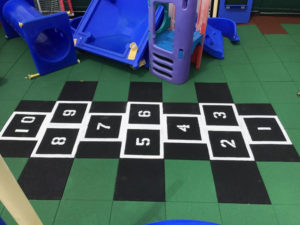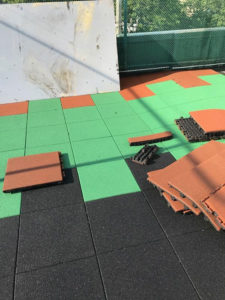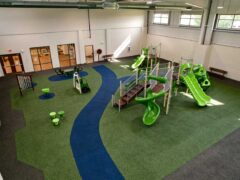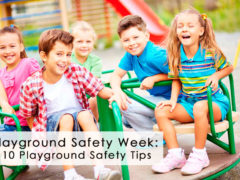
So you’ve got a playground in mind, but you’re trying to figure out what surfacing material will work best. You’re considering the basics: cost, aesthetics, safety, maintenance, etc. You’ve discovered prefabricated rubber tiles for playgrounds, a great solution, especially for small and hard-to-reach areas. While we tend to recommend poured-in-place rubber as the top choice, safety surface tiles for playgrounds are another great option, especially for rooftop playgrounds.
Let’s get your questions answered!
- Safety of Rubber Tiles for Playgrounds
- Cost of Rubber Tiles for Playgrounds
- Quality of Rubber Tiles for Playgrounds
- Installation of Rubber Tiles for Playgrounds

Safety of Rubber Tiles for Playgrounds
Pros:
The safety aspects of rubber tiles are what makes them a popular choice. When installed properly, they are:
- Shock-absorbent. American Standard Testing Methods (ASTM), the institution that sets industry safety standards, ensures the tiles we use are safe for falls from 6 feet (for 2.5-inch rubber tiles) up to 8 feet (for 4.25-inch tiles).
- ADA compliant. This means they’re wheelchair-accessible, and safe for kids with physical disabilities and limitations to play on. So if you’re looking to create an inclusive playground that all kids can enjoy, this is one of your best options.
- Ideal for those with chemical sensitivities. Parents and administrators don’t have to worry about rubber tiling causing a reaction in those with skin sensitivities and allergies. The products we use at adventureTURF use only premium rubber made from natural materials, plus EPDM rubber (which helps the surface resist cracks due to severe temperatures and weather), and SBR rubber (which helps the surface stay flat and supple). These materials are free of metal, wood, harsh chemicals, and other irritating compounds.
- Less falls. One of the big reasons we suggest rubber tiling for areas that will be in use while wet — for example, a pool deck or a playground after a rain shower — is because of its non-slip qualities. Due to the nature of rubber tiling’s porous surface, it remains a non-slip surface even when saturated with moisture.
Cons:
- If not installed properly, the grooves/edges of the tiles could creating a tripping hazard.

Cost of Rubber Tiles as Playground Flooring
Pros:
- The low maintenance costs of rubber playground tiles are one of their best assets. It’s easy to complete one-off repairs of tiles that are damaged — and it’s tough to damage them in the first place. Rubber tiling is durable, easy to clean, and will last for years before any type of maintenance is required, making it a budget-friendly option for your project.
- The price of installing rubber tiles for playground surfacing varies based on factors like the size of the playground surface, if it’s a rooftop installation or ground-level installation, and how much surface preparation is needed. Contact us for a custom quote for your specific playground.
Cons:
- The up-front cost is higher than cheaper options such as pea gravel, sand, and wood chips. Keep in mind that quality and cost can go hand-in-hand.
Quality of Rubber Mats on Playgrounds

Pros:
- The tiles interlock to create smooth seams that won’t trip seniors or sprinting kids.
- They’re great for indoor playgrounds and recreation areas, because the materials are easily transported and installed. Plus, they don’t create an overwhelming chemical odor.
- They come in a wide variety of colors, allowing you to get creative.
- Rooftop playgrounds are another good place for rubber tiles to be installed.
Cons:
- Rubber tiles don’t last forever (as does any playground flooring material). You can expect to need to start swapping out older tiles for newer ones after about a decade, in order to ensure they are providing proper shock absorbency.
The rubber playground tiles we use at adventureTURF measure 24×24 inches (which can be trimmed to fit into your space’s nooks and crannies) and come in two thicknesses: 2.5-inch and 4.25-inch. They’re available in a wide variety of colors, and can even be made into customized designs and patterns. Check out this rooftop playground surfacing installation in Queens, New York City to see an example.

Installation of Rubber Mats for Playgrounds
Pros:
- Installation is very simple compared to many other options. For example, adventureTURF was able to establish a partnership with a construction equipment company to lift pallets of the rubber surface tiles and other materials up to the rooftop of a childcare center in Brooklyn, New York City. You can see an in-depth description and photos of the project here.
- Rubber safety tiles can be installed in any pattern, so you can get creative — making them perfect for recreational, playground, and safety surfaces.
Cons:
- Installation should be done by a professional who has the right tools and experience.
Next Steps
As for any big decision, you’re going to want to compare options and dive into the details in order to make a final selection. You can read more about all of the rubber playground flooring options from adventureTURF and read our responses to FAQs listed below. We’ve also created a project gallery where you can browse some of the awesome designs we’ve completed across the country.
You probably still have questions. Please don’t hesitate to contact adventureTURF for answers! And, if you’re ready to take the next steps, reach out to us to request a free quote. We’d love to help you design the best, safest playground surface possible!
With so many different qualities and characteristics to consider, choosing a playground surface can be bewildering. That’s why we’ve created an ultimate guide of all the pros and cons of 11 of the most popular playground surfaces, from wood chips to recycled rubber mulch.
![]() We service the entire USA. Contact us for more information or get a free quote.
We service the entire USA. Contact us for more information or get a free quote.
FAQs About Rubber Tiles for Playgrounds
The safety aspects of rubber tiles are what makes them a popular choice. When installed properly, they are:
- Shock-absorbent
- Slip-resistant
- ADA compliant
- Ideal for those with chemical sensitivities
There are other safety considerations of rubber tiles for playgrounds.
This varies by weather/climate, amount of use, quality of the product and of the installation, and other factors. That said, you can expect to start swapping out older tiles for newer ones after about 10 years or so, in order to ensure they are providing proper shock absorbency. Learn more about the quality of rubber playground tiles here.
It all comes down to how you use the terms. Generally, you can think of them like this:
- Rubber playground tiles: Installed as the flooring of the playground area.
- Rubber playground mats: Used at specific places on the playground, such as at the bottom of slides, under swings, etc.
You can typically buy and install rubber playground mats yourself, but will need a professional installation company to install rubber playground tiles as the flooring/surfacing. Note that on our site, we use the terms interchangeably.
Some of the most popular uses of safety rubber tile surfacing include:
- Pool decks
- Patios
- Water parks
Playground rubber tile surfacing is the most popular application of it. Rubber safety tiles come in a variety of colors, creating virtually endless design options for playgrounds.


